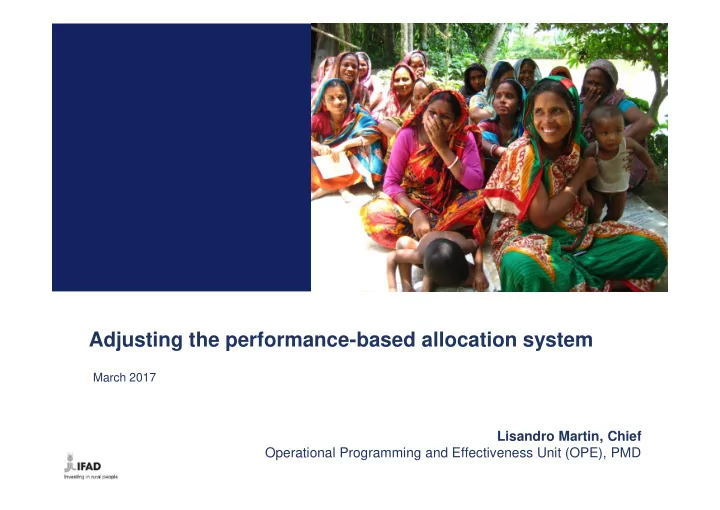

Adjusting the performance-based allocation system March 2017 Lisandro Martin, Chief Operational Programming and Effectiveness Unit (OPE), PMD
Today’s presentation Actions taken slide n. 3 Formula slide: 4 - 5 slide: 6 - 7 Scenarios New steps slide: 8 2
Actions taken Management actions in response to CLE recommendations Enhancing rural poverty focus Strengthening the performance component Development and inclusion of IFAD Vulnerability Index (IVI), which Country Policy and Institutional Assessment (CPIA): elimination and includes measures of vulnerability, income inequality, nutrition and folding within RSP non-income poverty. Rural sector performance assessment revision: revisiting underlying Realignment of RSP assessment with IFAD’s strategic frameworks indicators and questions; systematizing and strengthening the RSP Actions taken 2016-2025. scoring and quality assurance processes. RSP utilisation for policy dialogue and COSOPs development. Efficiency gains through RSP scoring once per cycle. Portfolio performance and disbursement (PAD): enhanced portfolio performance assessment and inclusion of a disbursement measure Rebalancing the needs and performance Streamlining PBAS management process components for better effectiveness and transparency Reviewing the weights of formula variables in order to increase the Enhanced reporting to Governing Bodies on allocations, countries performance-drive of the formula, while taking needs in due entering and exiting the cycle, capping, minimum and maximum account. allocations, reallocations. Reduction in rural population exponent. PBAS-related decision making approved by OMC and EMC, which have full interdepartmental representation. Increase in performance component exponent. Exploring options for reallocating resources earlier in the cycle. Generating learning through learning events for IFAD staff, the inter- departmental working group on PBAS, and informal seminars with the EB. 3
Formula Refreshing our understanding of the Performance based Allocation System How many people live in the How poor are the countries we rural areas? work in? The higher the rural poverty, the higher The bigger the rural population, the the allocation higher the allocation How good is the enabling How is IFAD’s portfolio environment for rural poverty performing? reduction? The better the enabling environment, The stronger the performance, the the higher the allocation higher the allocation 4
Formula Phase I introduced changes to the variables Reduce the range of Add a vulnerability Maintain measure variation -0.25 0.40 [( Rural Pop x GNIpc ) x (IVI) ] NEEDS 2 [ (0.65 x RSP) + (0.35 x PAR) ] PERFORMANCE Simplify and add Fold CPIA into RSP and merge disbursements: from PAR to their weight PAD 5
Phase II focused on the weights of the variables and Scenarios components: the four scenarios developed show stability across income groups but variations within fluctuate 56% 44% 54% 46% 45% 55% 48% 52% Needs Performance Scenario 1 Scenario 2 Scenario 3 Scenario 4 LICS $122m Max $135m $152m $152m $58.8m Nepal $56.9m $69m Rwanda Nepal Rwanda $97.1m Rwanda Low Income $53.5m Rwanda $53.2m Rwanda $46.7m Nepal $27.3m Nepal $34m Median $36m Countries $24m $8m Nepal $4.5m Min $4.5m $4.5m $4.5m LMICS $152m Max $152m $152m $152m $34m $36m $33m $38m Sri Lanka $24m Median Lower Middle $25m $26m $15m Income $4.5m Min $4.5m $4.5m $4.5m Countries UMICS $152m $152m $132m $137m Max $47m $60m Mexico $36m $34m $5m Upper Middle $5m $10m $9m Median Income $4.5m $4.5m $4.5m $4.5m Countries Min Although counterintuitive, a larger weight for one variable (or component) does not necessarily imply that countries with better scores in that variable receive more resources, even if that variable scores better than any other variable in the formula. Up to 45% to Sub-Saharan Africa Two-thirds highly concessional Income level Considering increased resources to MFS 6
Scenarios Comparative distribution of resources by selected scenarios share 46% 52% 35% Current IFAD10 Scenario 2 Scenario 3 share share 54% 48% 65% Needs Quintiles Needs Quintiles Needs Quintiles 6 6 6 5 5 5 4 4 Performance Quintiles Performance Quintiles 4 Performance Quintiles 3 3 3 2 2 2 1 1 1 0 0 0 0 1 2 3 4 5 6 0 1 2 3 4 5 6 0 1 2 3 4 5 6 UMICs 20% LMICs 80% Needs Needs Needs 0.4 -0.25 0.4 -0.25 0.45 -0.25 [( RurPop X GNIpc ) X (IVI)] [( RurPop X GNIpc ) X (IVI)] [( RurPop X GNIpc )] Performance Performance Performance 2 4 2 [(0.2 IRAI + 0.45 RSP + 0.35 PAR)] [(0.40 X RSP) + (0.60 X PAD)] [(0.20 X RSP) + (0.80 X PAD)] 7
Next steps Next steps Needs component: refining the weights of GNIpc and IVI Performance component: refining the weights of RSP and PAD Rural sector performance assessment: finalization of scoring methodology and Quality Assurance system . Refining the sensitivity and the elasticity analyses 8
Questions and discussion Any questions? Thank you
Recommend
More recommend